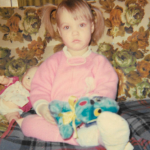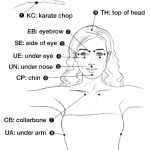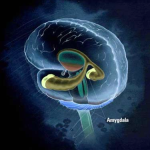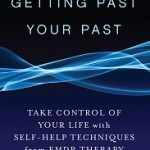 My Neurofeedback Journey
My Neurofeedback Journey
by Tina Marie Hahn
— as told to Kathy Brous
[Tina added on July 11: I am experiencing major changes in my brain functioning so fast with neurofeedback, although as of this writing, I have only been doing it for three months. But in six months I seriously don’t think I will recognize myself anymore, and I say that after decades of struggle. I truly recommend checking out neurofeedback, for anyone who has failed all the traditional approaches to trauma.]
I am Dr. Tina Marie Hahn, MD, advocate for Trauma-Informed Care and Communities, and survivor of actually ten Adverse Childhood Experiences (ACEs). As a pediatrician, I screen parents and children alike for childhood trauma. That’s me above at 30 months old and my background story is here: http://acestoohigh.com/2014/05…-her-ace-score-is-9/
I’ve been excited for some time to try neurofeedback, which I began on April 6, after listening to a talk given by Dr. Bessel van der Kolk and Sebern Fisher and reading Dr. van der Kolk’s latest book “The Body Keeps the Score” and a blog on Sebern Fisher’s work with neurofeedback here at http://attachmentdisorderhealing.com/neurofeedback/ I then read three books on neurofeedback, including Dr. Fisher’s book “Neurofeedback in the Treatment of Developmental Trauma: Calming the Fear-Driven Brain” and decided to research several electronic neurofeedback systems for home use.
I report as a user/patient, not as a doctor or expert, because my experience so far has been fairly stormy — I’m just starting out, so I don’t know where this will go and I am not an expert. I feel I should warn readers: if you have experienced severe infant and childhood developmental trauma as I did, neurofeedback seems like a very rewarding method for healing — but it has intense risks if not done with care.
Please if possible, as Kathy’s book says: “Don’t Try This at Home.” Neurofeedback is designed to be done in a trained practitioner’s office. So for most people with trauma, probably it’s best not to do neurofeedback alone at home. Please try to do it with access to formal support, hopefully a good attachment-based psychotherapist who is very compassionate, so you can discuss what is happening and process these deeply brain stem based emotions with another human. If therapy is really impossible, maybe you could create a group of healing friends or at least have a friend come regularly to be with you while you do it or afterward. Some type of support would be key.
I had to opt for a home-use neurofeedback system because I am in a rural backwater where everyone knows everyone so I don’t feel comfortable sharing incredibly strong emotions. I’ve also had prior bad experiences with psychiatry plus right now there aren’t good practitioners anywhere near where I live. In fact, I might be doing better if I had a well-trained therapist possessing extensive knowledge of developmental trauma.
As to the level of pain in my healing with neurofeedback so far: I have been working on this level of emotional pain for decades, so (thus far) it seems I have an ability to tolerate this intense experience. (I won’t know how much I can tolerate until I go further, who knows.) But I did want to note that unless a person is willing to take chances and is pretty strong, they might get really shaken up.
The Fear-Driven Amygdala
I wanted to specifically treat my fear-driven amygdala that I have from being terrorized as an infant and child. I found one home system, which looked good, but it did not allow one to use different protocols to specifically calm down an overactive amygdala.
So I chose BrainPaint®, which did, and I was excited to get my BrainPaint® home neurofeedback system in the mail April 6. BrainPaint® sent an excellent 47 minute video tutorial showing me how to set up the system and before the first session, I had an 1.5-hour phone tutorial. The system is very easy to set up and use. Also we get 45 minutes of assistance by phone every month we rent the system, and we can pay extra for more telephone help if we need it. I will be texting or calling my BrainPaint® “assistant” to help me as I become ready to change protocols based on symptom improvement.
BrainPaint® is not cheap but mental health and well-being? Priceless. The BrainPaint® set I got has a minimum two months rental at $675 per month for shipping and a deposit; I initially paid $1,875. The deposit comes back when you send the rental back. Here is an introductory YouTube video: https://www.youtube.com/watch?v=7s0AFjRVfmk
I did my first session April 7; it starts with a symptom checklist. I had lots of symptoms checked. The protocol chosen initially was to calm my right amygdala— but because it looked like so many areas were out of whack, I did something called “non-linear on T3 and T4″ (right and left temporal) to get the brain hemispheres in synch.
My first session was 7 minutes….. It was interesting.. Looking at a screen with fractal patterns and auditory inputs. After the first 7 minutes, I fell asleep for 2 hours. For me that is amazing because I don’t take naps and don’t sleep well… I feel relatively calm and just completed a second session for 14 minutes. I am now pretty tired.
I don’t know the outcome of this process, but I have a strong feeling that neurofeedback is going to help rid me of my low self esteem, my rough edges and though I am really tired, I think this is going to really make some good changes. It already did something, as normally looking at a computer screen would never make me take a nap.
More Good Results
On April 8, I had more good results: I did a few more BrainPaint® sessions throughout the day. Then last night I slept the best I have in months!
On April 20, I did an “Alpha-Theta” session on BrainPaint® and had a rather weird experience so here’s what happened:
I am stuck inside an ostrich shell. I am really stuck. I am little but grown. I am pushing on the shell. It doesn’t move and all around me is space …. lots of space.. me in a shell…
then I flash into the basement…. it is dark but there is a window a small window that is in the basement and I look outside trying to see the outside where it is light and bright and trees and leaves and I am stuck…
I don’t fight, I just flash back into the eggshell… then I think I cannot push this open… I will try to melt it away into infinity ..the infinity of equanimity ….. then it was done….
I suppose this is what we experience in the early sessions.
Major Trauma Release
On April 27, it had been about three weeks that I’ve been working with the BrainPaint® desktop home neurofeedback machine. I’ve been doing about 1.5 hours of neurofeedback a day. That turned out to be a little too much for me as a beginner, so I gave myself a break the last two days.
After my second “Alpha-Theta” training April 19, I could not stop sobbing during the session, or after — for 4 hours straight. It was cathartic. During the session my body was shaking — like really shaking. It reminded me of Peter Levine’s discussions and the video he has of the polar bear shaking after he was attacked and then later came out of the trauma. It was incredible. I wasn’t just thinking this poison was coming out of my body — I was feeling it. I was shaking worse than if I had been locked for several hours in a deep freezer…..
It really was amazing…. I let go of a lot of stuff. I saw that my mother did the best she could. I could see myself letting go of the residual anger.
Then, the anger was replaced with a tremendous well of grief and loss. I realized that I was full of so much grief over what could have been and how my life might have been different if this had not happened to me — how my mother’s life would have been different if she had been able to feel love from her children instead of being so stressed that she allowed the most horrific things to happen to her kids.
I thought about how my brother wouldn’t be psychotic if he hadn’t been hurt so much…. How he could know happiness instead of his constant fear…..
And please know: it might not be good for most people to do this alone, as the title of your book says, “Don’t Try This at Home.” For me, I’ve been working on confronting my childhood for decades, so I have an ability to tolerate this intense experience. But for most people, unless you are willing to take chances and you’re pretty strong, a person might get really shaken up. It would probably be good to have a therapist to discuss what is happening and to process those deeply brain stem based emotions — or a group of healing friends. To have someone with you to support you would be helpful.
I might be doing better if I had a therapist too, but like Kathy I’ve had bad experiences with therapy so my confidence in it is low and anyway I’m in a rural area without much available. But I think many people with severe childhood trauma like me who are considering neurofeedback might want to use it with formal support such as therapy or a support group.
For me, I wasn’t re-traumatized. That is all I want to say for now except I think this is a powerful tool!
Getting More Relaxed
By May 6, I found that we need to give the neurofeedback some time to settle into our brain, let the brain settle into new patterns. That’s why I’m not posting as much: I just don’t feel the need to reflectively respond to everything, and that means everything in general. For someone with trauma, that’s progress.
I have been able to work through my anxiety and though it seems strange, send the emails and make the telephone calls that I need to make but generally procrastinate on. I have been cleaning and organizing. Usually I am so disorganized I am not good at this.
Now I am less reactive. I am certain of it. When talking to others and they say something that would generally trigger me – I might still become triggered but there is more of a second or two to contemplate first.
I stopped doing several hours of neurofeedback per day. I think so much was making it very confusing for me to determine what was going on in my brain. While I think generally it has all been effective, I like the general stabilizing non-linear protocol I began with. I have done several more sessions of the “Alpha-Theta.” That is the type that has the capability to take us into the deep meditative state.
I haven’t had anymore of those really emotional spells during the “Alpha-Theta,” but my dreams have been more colorful. Actually last night I had the first dream in color and it was sad, but more positive. Usually my dreams have always about big mean things trying to kill me. So that is great, too.
I feel like I am better able to sit back, take in others point of view, back off from feeling like I have to do everything myself. I really feel this is great. I also attribute it to the neurofeedback. I feel like I could talk to people much easier now and have a great interactive conversation without feeling strange and out of place inside. This is all awesome to me.
And I am feeling like moving into other areas of healing like meditation which I am not good at because of a “way too busy mind that is always quadruple tasking”. I actually sat down and did about 15 minutes of sitting meditation yesterday and that was good. So I think all in all this has been a very positive process for me.
I have also been taking others suggestions or at least listening and then making I think more informed decisions based on information from others. To me this is the start of trying to connect.
Also, though I don’t use Facebook much, I have been posting on Facebook more recently and will see people I know. Before, I would be afraid to send a friend request — I would be too afraid because I’m a bad person, that person wouldn’t want to be my friend. But now, I have been taking chances, sending friend requests and guess what – people have been accepting. I just find this totally weird for me. I don’t look out of control outside but now, I am starting to feel more competent instead of “out of control inside.” By that I mean that strange anxiety when you feel like you don’t belong, like you are an alien to a foreign species. But now I’m starting to feel I do belong more, I’m feeling more human.
A Breakthrough or Epiphany?
On June 8, I wrote that I haven’t posted on my use of the BrainPaint® neurofeedback system for a month for a few reasons.
Good reasons: I felt so much better due to neurofeedback that I got too busy! I’ve been out a lot, creating and attending meetings about the ACE Study and regional trauma-informed schools, and I’m writing several articles. I’ve begun working on key things I used to procrastinate on, that’s also getting better with neurofeedback… I can feel a real improvement in my impulse control and affect regulation (my ability to regulate my emotions is growing nicely.)
I still feel neurofeedback benefiting me in daily activities, for example if I want to write something that makes a point, I do it so that it’s not impulsive, and is worth reading. My new ability to do that is part of the neurofeedback.
But I also missed a lot of BrainPaint® sessions. On the one hand, we do need time for the neurofeedback changes to settle into our brain. But I got 2-3 weeks behind so let me note: For anyone who decides to do home neurofeedback, it is important to follow the BrainPaint® policy to rate your goals and answer the assessment questions before each session, and also be careful to keep up with the updates they issue to their computer system.
I got behind on that because my cursor wasn’t working properly, I was blaming myself, so I missed a lot of sessions. Finally I called my BrainPaint® home neurofeedback coach and we learned it wasn’t my fault — the program needed an update, so it was updated on Friday [June 5].
Then we reviewed and updated the BrainPaint® assessment together that calculated new protocols and she told me to stop trying to do everything on my own, to please call for help. I promised to follow the directions and did so over the weekend and — wow, did my brain move with the new protocols the system created!
In fact, as I was doing my session with the directed protocols, I came to what I have to call an epiphany. Something has happened to me which feels weird, in fact it feels absolutely crazy (compared to how I used to feel).
I want to report it because it must be the neurofeedback which is really helping me. OK:
I’m often scared to take my dogs to the vet because the office is on a main highway, and the dogs jump out of the car as soon as a door is opened. I’ve been afraid one would jump out and get hit by a car. I have to put them in the back of the RAV4 when driving or I get a 60 or 45 pound dog in my lap, but I couldn’t get them out the back door due to trouble with the auto-lift gate.
Now yesterday while I was doing neurofeedback, for the first time in my life it hit me: Hey, I could go inside the vet’s office and simply ask a front desk person to help me so my dogs don’t jump out and get hurt. This sounds so stupid but it isn’t — it means for the first time in my life I considered asking another person for reasonable help!
That means believing people are supposed to help each other and that some people can be approached for help.
That’s a first step in trust. Amazing.
So I began to weep, really weep.
Let me explain why this feels so weird and crazy and amazing to me.
As many of us with a high Adverse Childhood Experiences (ACE) score, people have horribly hurt me. I’ve come to feel, I want no part of mammalian attachment to people (you call that “fur”) — even if it is the only way to heal. Trusting people is horribly scary for me for reasons like this:
When I was 7 or 8, I was with my dad in the car about an hour away from our trailer. I never asked my dad for anything because he was incredibly mean. My dad smoked in the car with us kids inside. But on this winter day, I had a cold, and as he is smoking, I suddenly couldn’t breath. I am scared to death because I cannot breath. I timidly ask him “Dad could you please stop smoking? I cannot breathe.” His response was “If you don’t like it, I can drop you off here right now and you can walk home!” A very typical response. I don’t know how I managed to escape with my life in that small car for an hour as he puffed away while I was close to respiratory arrest… but I never forgot the incident or the horrible insensitivity.
From that time forward, I could not ask for anything reasonable – I could not ask for something reasonable to save my life.
To others, asking for assistance may seem like a no-brainer. But for me, tremendously hurt by my parents for years starting at a young age — to consider in the middle of today’s neurofeedback session that I could ask the vet for reasonable help — it made me weep.
And I’m going to try to no longer react immediately, even to such epiphanies, as I want to be more reflective going forward — another amazing plus of neurofeedback. But wow, I have experienced an amazing movement of my brain that I don’t think could have occurred any other way.
I may even be able to move to where attaching to people becomes okay.
Oh and as I had this epiphany – my dogs ate my dinner and I didn’t get mad!
———————————
Kathy’s blogs and Guest Blogs explore the journey of recovery from childhood trauma by learning about Adult Attachment Disorder in teens and adults, Adult Attachment Theory, and the Adverse Childhood Experiences (ACE) Study.
![]()




















